The Stonehenge Code: Unveiling its 10,000-Year-Old Secret
Contents
Introduction
Recent carbon dating from the Bluestone quarry sites offers compelling and irrefutable mathematical evidence that Stonehenge’s construction dates back to the Mesolithic era. This new data suggests Stonehenge is 5000 years older than experts had previously believed, challenging established views on its origins and adding new depth to our understanding of this ancient monument (The Stonehenge Code).
Papers by researchers from the University of London, Southampton, and Manchester, including Mike Parker-Pearson and his team, have significantly advanced our understanding of Stonehenge’s origins. The discoveries at the Craig Rhos-y-Felin quarries and the bluestone megaliths at Carn Goedog, which reveal that Stonehenge may have been initially built in Wales and then transported to Salisbury Plain 500 years later, are no longer credible.
This groundbreaking revelation has captivated archaeologists worldwide and challenged previous beliefs about the construction of Stonehenge. The idea that these bluestones were quarried, shaped, and then moved to Salisbury Plain offers a deeper understanding of prehistoric people’s capabilities and social organisation.
The transport of these massive stones over such a distance, centuries after their initial quarrying, suggests remarkable dedication and coordination. It highlights the profound significance these stones—and the monument they form—held for ancient communities.
As an enthusiast of ancient civilisations, I find this research thrilling. It deepens our appreciation for the ingenuity and spiritual dedication of our ancestors, opening new avenues for exploring cultural and religious connections across prehistoric Britain. (The Stonehenge Code)
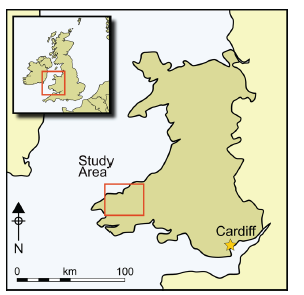
Craig Rhos-Y-Felin
The December 2016 edition of Antiquity Magazine featured a report titled “Craig Rhos-y-Felin: a Welsh bluestone megalith quarry for Stonehenge,” unveiling intriguing insights into the origins of Stonehenge’s bluestones. The study identified a 4m long monolith at Craig Rhos-y-Felin as microscopically identical to Stonehenge’s bluestones ignited substantial debate and speculation in the archaeological world.
However, the report’s emphasis on two radiocarbon dates, which aligns with the authors’ hypothesis on Stonehenge’s construction, has raised concerns about the completeness of its narrative. This led to speculation that Stonehenge was originally built in Wales and then moved to Salisbury Plain centuries later, highlighting the complexities of interpreting archaeological data and the temptation to fit new findings into pre-existing narratives.
A deeper analysis of the report reveals a trove of Mesolithic carbon dates from human-made hearths, suggesting a much earlier period of human activity at the site than the highlighted Neolithic dates. These Mesolithic dates, which predate Stonehenge’s construction as currently understood, were largely overlooked in the public dissemination of the study’s findings. (The Stonehenge Code)
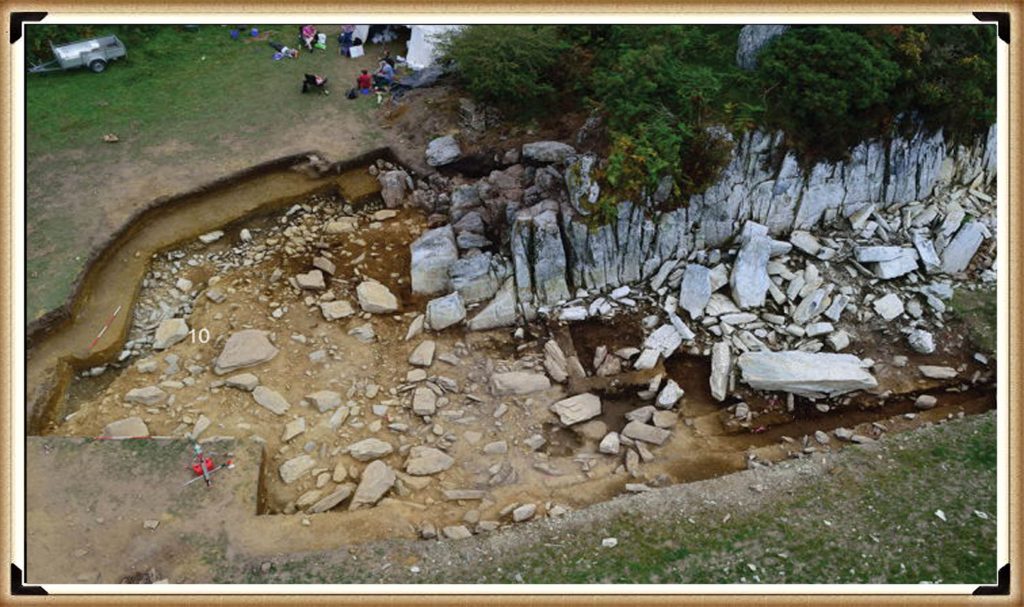
This oversight brings to light crucial questions about the narrative surrounding Stonehenge’s origins and the methodologies employed in archaeological dating. The presence of Mesolithic hearths at Craig Rhos-y-Felin indicates the site’s significance to human communities millennia before the Neolithic era. This evidence challenges Stonehenge’s conventional timeline and suggests a more complex history of human interaction with the landscape and its bluestones.
Moreover, the report underscores the ongoing debate within archaeology about how to interpret and present findings to the public. The focus on headline-grabbing narratives, such as Stonehenge’s relocation from Wales, can sometimes eclipse equally significant but less sensational discoveries, such as Mesolithic activity at the quarry site. (The Stonehenge Code)
Stonehenge Old Car Park

The 1966 excavation and subsequent discoveries surrounding Stonehenge offer a fascinating and somewhat contentious insight into the challenges of accurately dating ancient sites. Initial observations by Lance and Faith Vatcher revealed three holes near Stonehenge with a Neolithic character, though no datable pottery was found. Yet, the characteristics of the holes suggested a Neolithic origin. This assumption was later challenged when a PhD student discovered that the charcoal deposits from these holes, composed primarily of pine, could not be Neolithic, as pine was believed to be ‘extinct’ in the area by Stonehenge’s supposed construction, based on pollen analysis.
This revelation was startling, particularly to officials from the Historic Buildings and Monuments Commission, now known as English Heritage. Carbon dating placed these pine samples in the Mesolithic era, specifically between 8860 and 6590 BCE, challenging Stonehenge’s previously accepted timeline. Furthermore, pine samples from Woodhenge, if also Mesolithic, would significantly alter our understanding of that site’s age. (The Stonehenge Code)
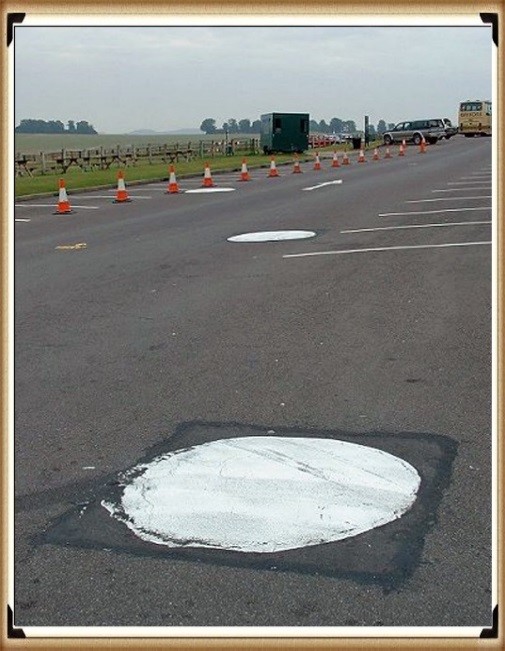
Rather than seizing the opportunity to explore these findings further, a narrative emerged dismissing these posts as totem poles from unrelated, wandering hunter-gatherers. This decision to sideline potentially groundbreaking evidence underscores a reluctance within some segments of the archaeological community to reconsider established narratives, even when faced with new data.
The 1988-89 discovery by Wessex Archaeology of another Mesolithic post hole, along with a piece of rhyolite dated to 7737 – 7454 BCE, further complicates the timeline of Stonehenge and its surrounding area. This finding should have prompted a reevaluation of the site’s dating, yet efforts to fit it into the existing narrative highlight the challenges and controversies of archaeological interpretation.
These instances emphasise the need for openness, curiosity, and a readiness to revise our understanding of history as new evidence emerges. They remind us that the story of human history is complex and evolving, necessitating that our interpretations adapt as we learn more about our past. (The Stonehenge Code)
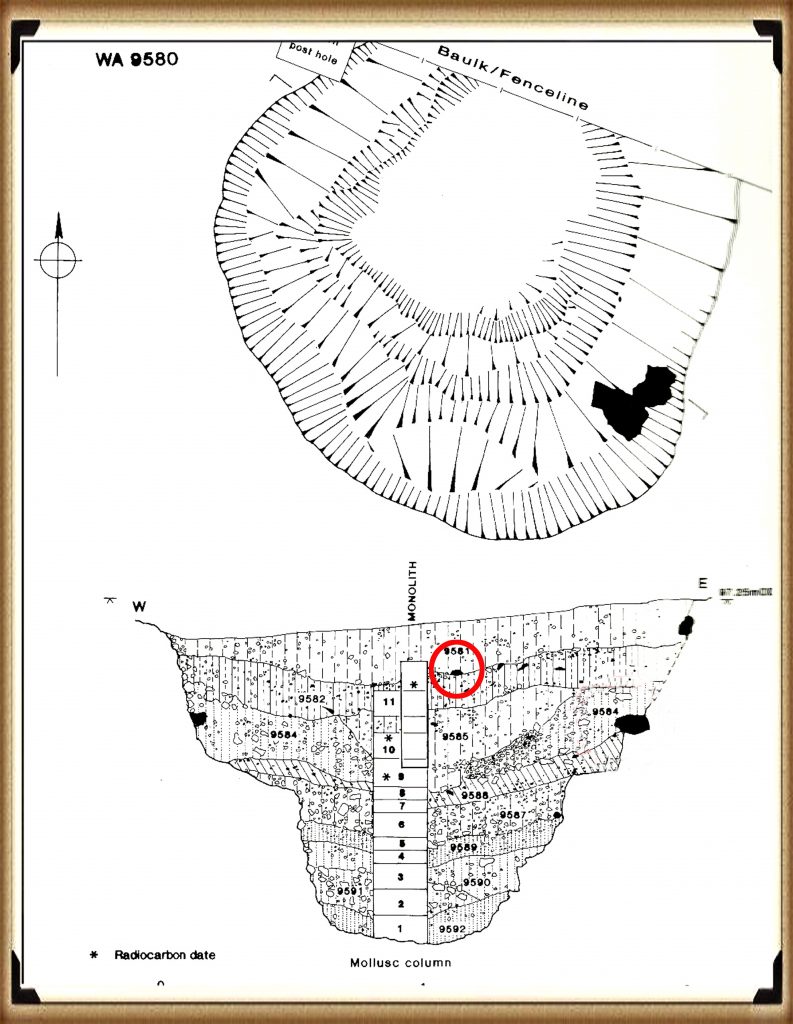
Discoveries at Stonehenge, including charcoal (OxA-18655) found in the hole socket of Stone 10, dating back to 7330 – 7060 BCE, align with the Mesolithic post holes’ dates, offering significant implications for our understanding of the site’s history. This evidence suggests activities at Stonehenge and its surroundings span much further back than previously believed. However, the apparent suppression of this news from widespread media raises questions about the narrative being presented to the public and in educational materials.
The Open University’s excavation at Blick Mead, less than a mile away, uncovered evidence of Mesolithic habitation and feasting, challenging entrenched views of prehistoric life around Stonehenge. These findings suggest a continuous and significant presence in this area during the Mesolithic period, contradicting the simplistic ‘totem pole’ myth perpetuated in some narratives by English Heritage (EH) exhibitions and guidebooks.
Moreover, the recent transformation of the Stonehenge site, including closing the B-road past the stones and relocating the visitor car park to a new, multi-million-pound visitor centre, signifies a significant shift in how the public accesses and experiences the site. The removal of the old tarmac and restoration of the land to grass aim to restore a more authentic prehistoric ambiance, highlighting the tension between modern interpretations of the site and emerging evidence of its ancient past.
Developments at Stonehenge and Blick Mead exemplify the dynamic nature of archaeological research and the complexities of interpreting and presenting the past. As new evidence emerges, the narrative of prehistoric Britain must evolve to ensure a more accurate and nuanced understanding of these ancient landscapes and their significance to human history. (The Stonehenge Code).
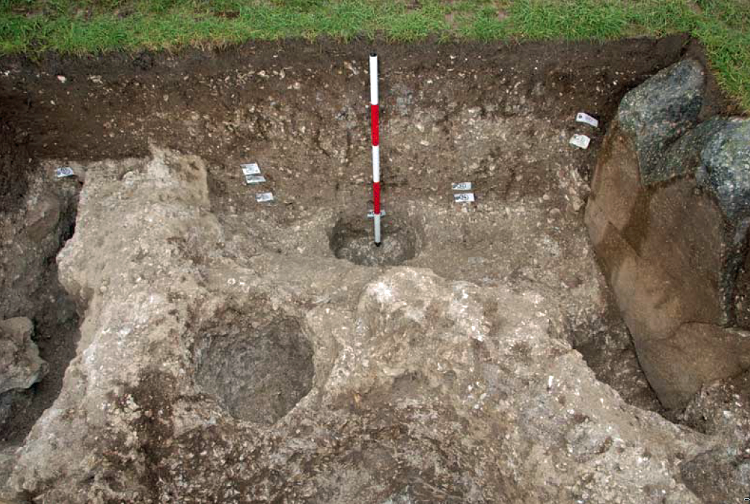
You’d think that removing the tarmac from the old visitor’s car park at Stonehenge, especially given the previous significant findings beneath it, would lead to a comprehensive excavation to uncover more evidence about the site’s Mesolithic history. Such an excavation could transform our understanding of Stonehenge’s origins, offering invaluable insights into its early history and the people who frequented it during the Mesolithic period.
Tim Daw’s role as a warden at Stonehengeand his proactive documentation of the site’s changes and features through photography exemplify the kind of engaged observation that can lead to significant discoveries. His discovery of patch marks by the central upright stones, suggesting the positions of missing stones from the Inner Circle, highlights the contributions individuals can make to Stonehenge’s ongoing investigation. Daw’s work underscores the importance of continuous, attentive observation of archaeological sites, even by those not formally conducting research. (The Stonehenge Code).
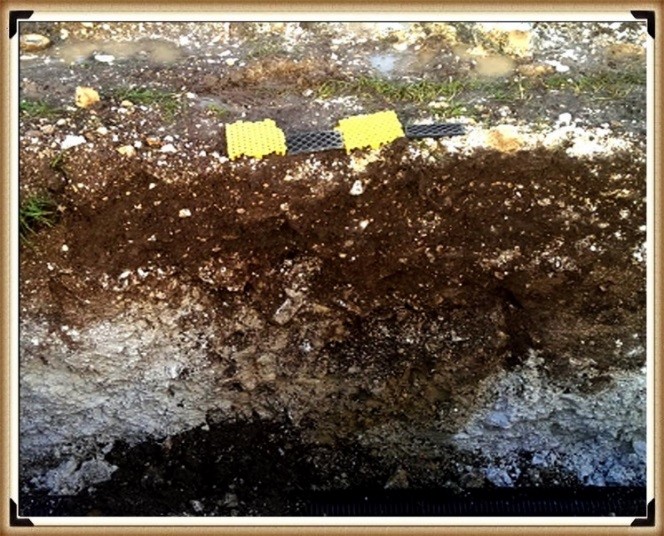
The discovery of such featuresand the potential for further findings beneath the former car park underscores the need for thorough and systematic archaeological examination whenever opportunities arise. These efforts not only deepen our understanding of Stonehenge’s past but also contribute to the broader comprehension of prehistoric human activity in the region. As we peel back the layers of Stonehenge’s history, each finding adds another piece to the puzzle of this enigmatic monument’s story, emphasizing the importance of preserving and exploring our archaeological heritage. (The Stonehenge Code).

Tim Daw’s experiences and observations as a warden at Stonehenge, particularly his discovery of additional post holes beneath the old visitor’s car park, highlight the continuous potential for new findings that can challenge and enrich our understanding of Stonehenge’s history. Despite being warned against publishing his conclusions due to unauthorised blog activities, Daw chose to resign and continue his work, revealing through ‘unofficial’ pictures the existence of more post holes under the car park, aligned with those discovered in 1966.
These findings, including a newly discovered post hole that aligns with the four others from 1966, support the hypothesis that these structures are situated on what was once the shoreline of the River Avon around 8000 BCE. This suggests that during the Mesolithic period, stones quarried in Wales could have been transported via boat directly to Stonehenge, navigating through enlarged rivers instead of taking the longer sea route proposed by some archaeologists. (The Stonehenge Code)
Welsh Bluestones
Further complicating the narrative are analyses of the bluestone structures from other Preseli sites, like Carn Goedog and Craig Talfynydd, which are connected by streams and rivers to the River Nevern. Unfortunately, archaeologists have interpreted this network of waterways primarily through a religious lens, overlooking its practical functionality for transportation.
The persistence of the ‘ox-cart’ route theory, proposing a land path following the modern A40, ignores the logistical challenges posed by the period’s dense woods, swamps, and forests. Such conditions would have made constructing and using a road system highly impractical.
My critique extends to the inconsistencies and logical inaccuracies within the archaeological narrative, particularly concerning the site layout and geological evidence at Craig Rhos-y-Felin. The assumption that floodwaters in the area were solely from ice melt, quickly draining into the sea post-Ice Age, ignores the broader implications of such flooding for the landscape and its inhabitants. (The Stonehenge Code).
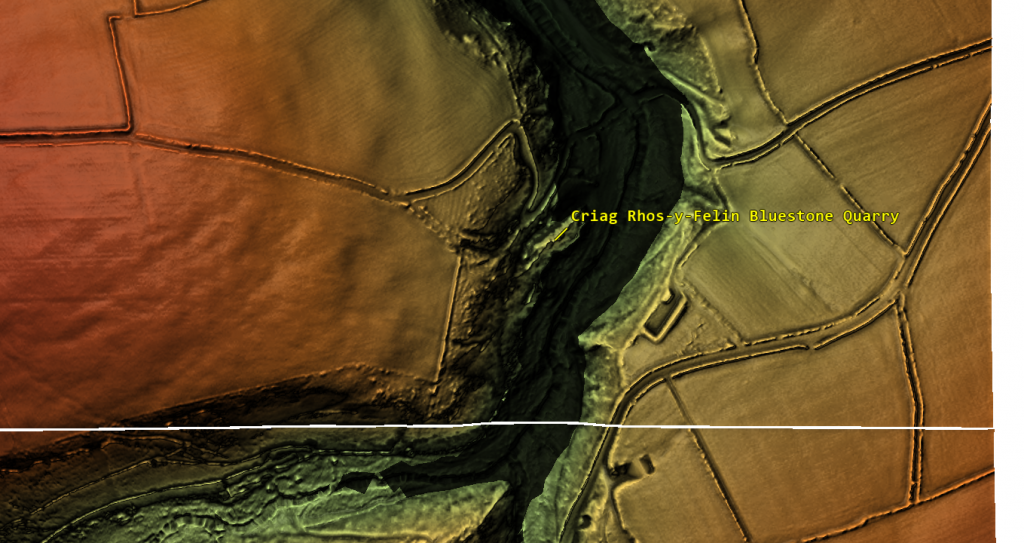
We confirm within the report that an old river ran around this quarry as long ago as 5620 – 5460 BCE and possibly up to 1030 – 910 BCE. (The Stonehenge Code).
“Most of the site was then covered by a layer of yellow colluvium (035), dated by oak charcoal to 1030–910 cal BC (combine SUERC-46199; 2799±30 BP and SUERC-46203; 2841±28 BP). This deposit is contemporary with the uppermost fill of a palaeochannel of the Brynberian stream that flowed past the northern tip of the outcrop. Charcoal of Corylus and Tilia from the basal fill of this palaeochannel dates to 5800–5640 cal BC (OxA- 32021; 6833±40 BP) and 5620–5460 cal BC (OxA-32022; 6543±37 BP), both at 95.4% probability.”

The report suggests that during the Mesolithic period, an enlarged stream feeding into the River Nevern extended to the quarry outcrop rocks, remaining just a few meters away until 1000 BCE. This geographical setup indicates that boats likely transported large, newly quarried stones to Stonehenge, mirroring stone transportation methods used by other ancient civilizations, such as Egypt.
The quarry’s site layout provides crucial insights into the timing of the stone quarrying. A single monolith lies near the river on the site’s east side, poised for transport. Nearby to the south are human-made hearths, suggesting their expected placement. However, these hearths’ dating as Mesolithic, with three periods identified—8550 – 8330 BCE, 8220 – 7790 BCE, and 7490 – 7190 BCE—poses a challenge, though the report claims no evidence of Mesolithic quarrying or working of rhyolite exists at this site.
This claim overlooks the practical use of tools across different periods. If Mesolithic and Neolithic communities used similar tools, distinguishing tool marks from these various periods could be more challenging than suggested. Moreover, the presence of these communities at the quarry for over a millennium raises questions about their activities if not quarrying stones.
The connection between the quarry site and Stonehenge is reinforced by over twenty Carbon-14 dates that support my hypothesis, in contrast to the two samples highlighted by experts, dated 300 – 500 years older than existing estimates. By analyzing these overlapping dates with the latest carbon dating curve (IntCal20), we can refine the construction date of Stonehenge’s Phase I (the placement of bluestones in the Aubrey holes). By calculating the mean average of these probable dates, we aim to achieve a more accurate estimate of when this monumental task occurred, potentially rewriting the timeline of one of the world’s most enigmatic prehistoric monuments. (The Stonehenge Code).
| Stonehenge | Old Car Park (Ref. and Date) | Craig Rhos-Y-Felin Ref | Craig Rhos-Y-Felin Dates | Carn Goedog Ref & Dates |
| Post Hole A | HAR-455 (8825 – 7742) | SUERC-50761 OxA-30507 OxA- 305481 SUERC-51164 SUERC-50760 OxA-30549 SUERC-51165 OxA-30506 OxA-305482 OxA-305062 OxA-30547 OxA-30504 | 8550 – 8330 8471 – 8285 8286 – 8163 8289 – 8169 8211 – 7955 8238 – 7941 8216 – 7785 8021 – 7792 8122 – 7962 8207 – 8030 8012 – 7711 8281 – 8166 | |
| Post Hole B | HAR–456 (7377 – 6651) | OxA-305032 | 7232 – 7188 | OxA31823 – 7190 to 6840 |
| WA 9580 | GU-5109 (8259 – 7742) | OxA- 30548 SUERC-51164 SUERC-50760 OxA-30549 SUERC-51165 OxA-30506 OxA-305482 OxA-305062 OxA-30547 OxA-30504 | 8286 – 8163 8289 – 8169 8211 – 7955 8238 – 7941 8216 – 7785 8021 – 7792 8122 – 7962 8207 – 8030 8012 – 7711 8281 – 8166 | |
| WA 9580 | QxA-4219 (7737 – 7454) | Beta-392850 OxA-30547 | 7944 – 7648 8012 – 7711 | OxA-35184 – 7590 to 7380 |
| WA 9580 | QxA-4220 (7595 – 7178) | SUERC-51163 OxA-30523 OxA-3050311 | 7539 – 7308 7472 – 7182 7485 – 7248 |
Table 1– Matching Carbon Dates
Calculations indicate that work at the quarry began around 8300 BCE, with its main phase of activity around 8000 BCE, and continued for at least a millennium, challenging the conventional narrative about Stonehenge and its bluestones. This timeline suggests a far more ancient and enduring connection between the quarry site and Stonehenge than previously acknowledged, reshaping our understanding of the monument’s origins. (The Stonehenge Code)
Carn Goedog
Initially, Carn Menyn in the Preseli Hills was believed to be the source of Stonehenge’s spotted dolerite. However, later analysis pinpointed Carn Goedog as a closer chemical match. Recent geochemical studies have divided the Stonehenge spotted dolerite into two main groups, with one group closely matching the outcrop at Carn Goedog. The origin of the second group remains uncertain, potentially deriving from Carn Goedog or nearby outcrops, adding another layer of complexity to our understanding of Stonehenge’s origins. (The Stonehenge Code).
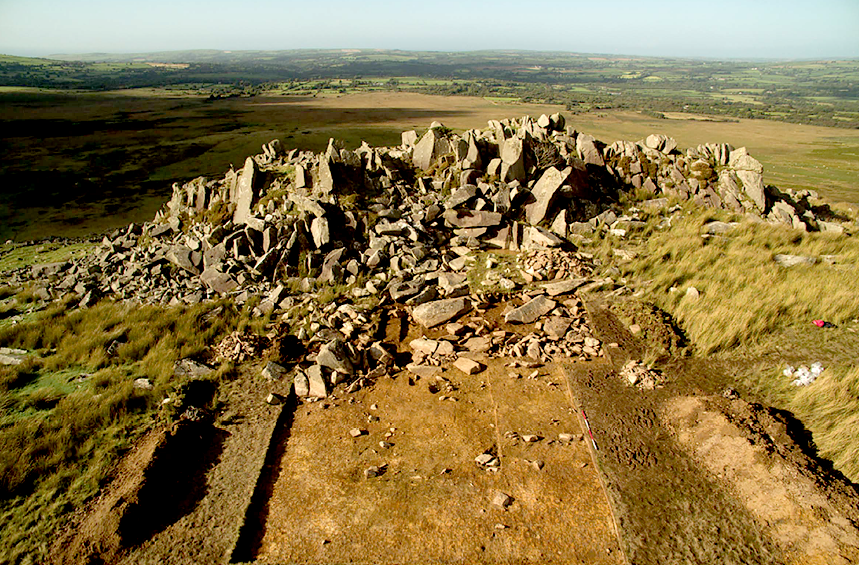
Further geological investigations at Stonehenge have identified additional sources for its bluestones. Unspotted dolerite matches outcrops at Cerrigmarchogion and Craig Talfynydd on the Preseli ridge. Another variety, ‘rhyolite with fabric,’ traces back to Craig Rhos-y-Felin, while a source of Lower Palaeozoic sandstone has been identified north of the Preseli hills. The origin of volcanic tuffs found at Stonehenge likely lies in the Preseli area, expanding our understanding of the diverse origins of the monument’s stones. (The Stonehenge Code).
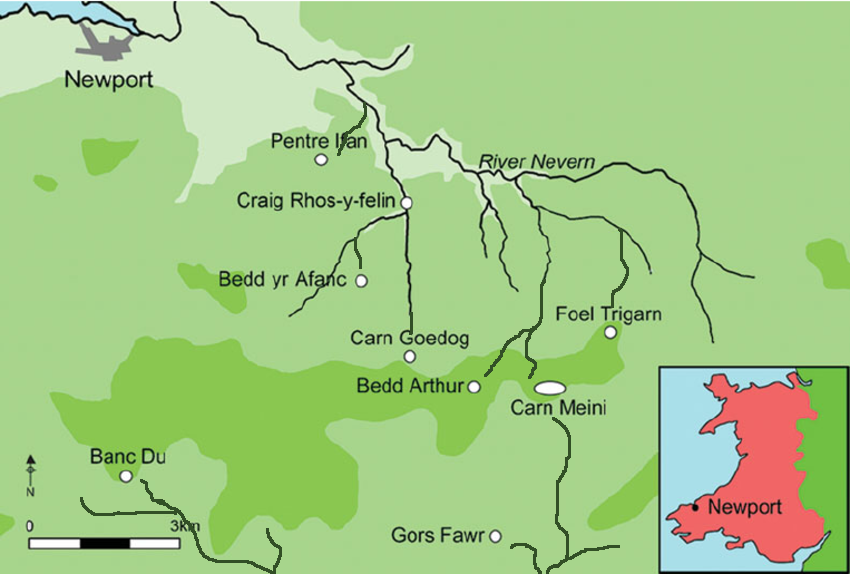
Surface indications of post-medieval quarrying, particularly on Carn Goedog’s south side, have demonstrated its accessibility. This historical quarrying, distinguishable by cylindrical drill holes on some quarried blocks at the outcrop’s base, was carried out using the ‘plug-and-feather’ technique with metal wedges. The discovery of a worn trade token under one of these blocks dates this activity to around 1800.
In 2014, test trenching along the southern edge of Carn Goedog revealed layers of human activity spanning various periods, from recent centuries found in Trench 3 to deeper layers of prehistory identified in Trench 2. Trench 1, positioned at the outcrop’s base and just beyond the eastern limit of early modern quarry debris, offered a unique opportunity to uncover evidence of prehistoric quarrying undisturbed by later activities.
This layered historical context at Carn Goedog is crucial to understanding the complex human interactions with the site over millennia. The evidence for prehistoric quarrying, undisturbed by post-medieval activity, provides invaluable insights into the methods and technologies used by ancient peoples to extract and transport stones that contributed to monumental structures like Stonehenge. (The Stonehenge Code).
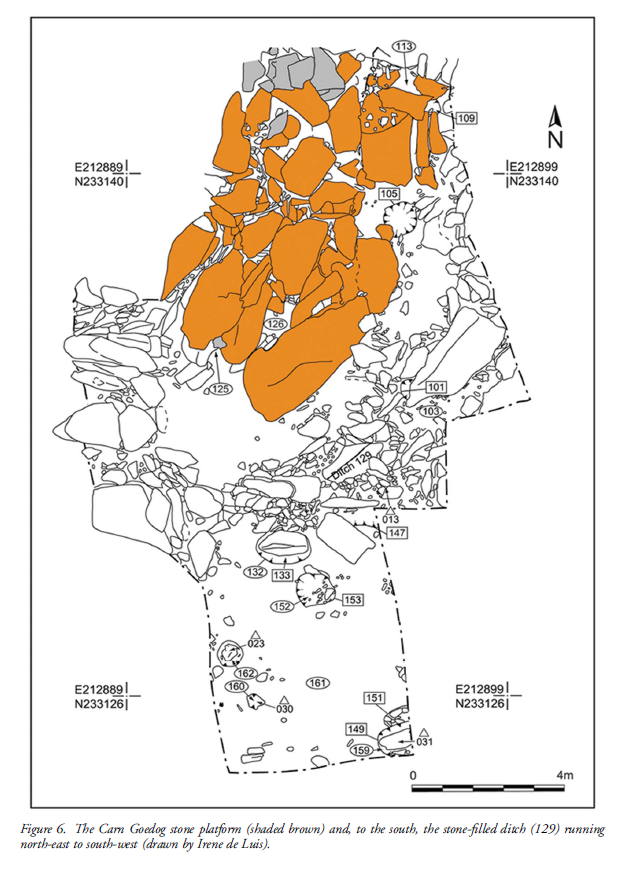
In 2015 and 2016, Trench 1 was enlarged to reveal features potentially related to prehistoric quarrying activity. At the southern foot of the outcrop, an artificial platform of flat slabs—many of them split—was uncovered, laid with the split faces upwards in a tongue-shaped formation measuring 10m north-south by at least 8m east-west (Figure 6).
Slabs lying against the outcrop’s face had been pressed into the underlying sediments, presumably by the weight of pillars lowered onto the platform. The platform ends with a vertical drop of 0.9m from the outcrop to the ground surface beyond. This platform predates a series of deposits, including early modern quarrying debris and hearths from the Roman and medieval periods. One hearth (Figure 6: 105), set in a gap in the platform where a slab had been removed, produced charcoal dating to 7190–6840 cal BC (8091±38 BP) and 2890–2630 cal BC (4164±30 BP) (Table 1)
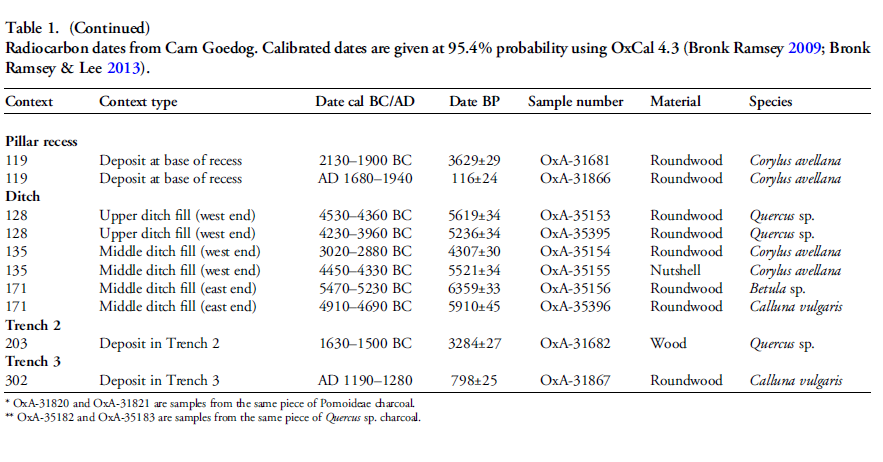
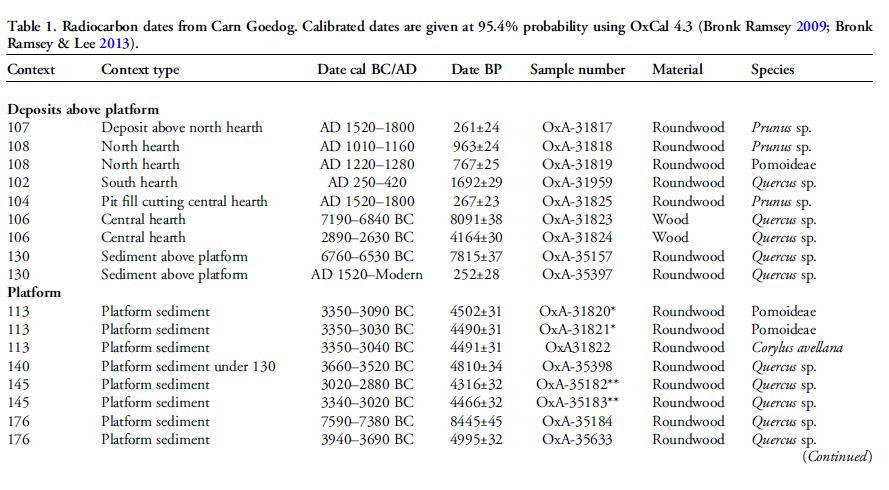
The Stonehenge Layer
The findings across the quarry sites, including Carn Goedog and Craig Rhos-y-Felin, suggest a nuanced understanding of how the bluestones were utilised and replenished at Stonehenge. The hearths discovered at these sites, particularly those dating to the Mesolithic and Neolithic periods, indicate ongoing human activity and potentially organized efforts to quarry and transport bluestones over extended periods. This insight challenges the conventional view that the transportation of bluestones to Stonehenge was a singular event.
Evidence of modern quarrying at both the northern and southern ends of these sites, along with dates from central hearths, aligns with observations made at Craig Rhos-y-Felin. Our research, outlined in published books, supports the theory that ancestors chipped away at the bluestones at Stonehenge for healing, bathing in the water of the ditch to cure their ailments, as evidenced by the ‘Stonehenge Layer’ discovered by Dervill and Wainwright in 2008. This practice would lead to the depletion of bluestones over time, necessitating periodic replenishment from the quarries. (The Stonehenge Code).
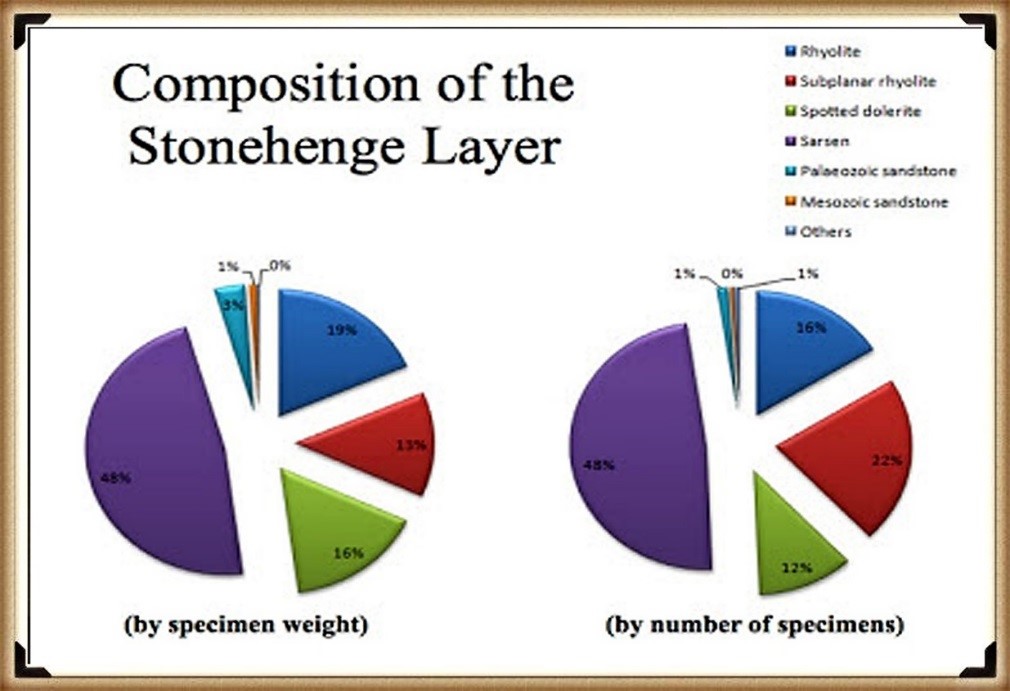
The conventional narrative, which posits that the bluestones were transported to Stonehenge in a one-off event, must account for the scientific data emerging from these quarry sites and Stonehenge itself. The evidence suggests a more complex interaction with these stones, involving repeated quarrying and transportation activities that likely spanned centuries. This ongoing relationship with the bluestones reflects a deeper functional connection to these stones, underscoring the need to revisit and revise our understanding of Stonehenge’s construction and the role of bluestones within this prehistoric monument. (The Stonehenge Code)
AI-Verified Mathematical Model: Radiocarbon Probability Proof
We’ve re-run our radiocarbon work with an updated 3 σ (three-sigma) model, refining the original bluestone and Mesolithic dates from Stonehenge and the two Craig Rhos-y-Felin quarries; the revised assumptions and maths are presented here, with every sample’s calculation listed in the Appendix at the end of the post. (The Stonehenge Code)
Revised Section — AI-Verified Radiocarbon Model
To work out whether the Stonehenge post-holes really belong to the same Mesolithic activity that produced bluestone debris at Craig Rhos-y-Felin and Carn Goedog, we ran a head-to-head test of their calibrated radiocarbon ranges instead of relying on “they look roughly the same age”.
- Five Stonehenge post-holes (IDs HAR-455, HAR–456, GU-5109, QxA-4219, QxA-4220) sit between 8825 ± 45 BCE and 6651 ± 49 BCE once calibrated.
- Twenty-seven quarry samples span 8550 ± 30 BCE to 6840 ± 30 BCE.
- Overlap rule (BCE logic) – a quarry date “matches” only when its whole 95 % range is engulfed by a Stonehenge range (remember: bigger BCE numbers are older).
- Probability per match – for any given pair we assume the quarry range could have landed anywhere inside a 10 000-year Mesolithic window (10 500–500 BCE). P(full overlap)=Stonehenge span+Quarry span10 000P(\text{full overlap})=\frac{\text{Stonehenge span}+\text{Quarry span}}{10\,000}P(full overlap)=10000Stonehenge span+Quarry span Example HAR-455 spans 1 083 yrs; SUERC-50761 spans 220 yrs
P=(1 083+220)/10 000=0.1303 (≈ 1 in 7.67)P=(1\,083+220)/10\,000=0.1303\;(\text{≈ 1 in 7.67})P=(1083+220)/10000=0.1303(≈ 1 in 7.67). - Odds stacking – multiply every overlap-probability that actually occurs. If no overlap, we drop that pair (probability = 0).
What changed after checking the original spreadsheet?
- Data tidy-up – one spurious “Odds = 10 000” entry sneaked into the Excel file. Replacing it with the correct 0.0654 fixed an inflated intermediate total.
- Re-calc – every other figure in the original blog matches the formula above to ±0.0001.
Headline results (details in Appendix A & B, scrollable above)
| Stonehenge sample | No. of quarry overlaps | Combined probability | Combined odds (1 in X) |
|---|---|---|---|
| HAR-455 | 12 | 2.29 × 10-11 | 4.37 × 10¹⁰ |
| GU-5109 | 10 | 4.41 × 10-12 | 2.27 × 10¹¹ |
| HAR–456 | 1 | 7.70 × 10-2 | 1.30 × 10¹ |
| QxA-4219 | 2 | 3.38 × 10-3 | 2.96 × 10² |
| QxA-4220 | 3 | 2.99 × 10-4 | 3.34 × 10³ |
Multiplying those five combined probabilities gives an overall odds‐ratio of 1 in 1.27 × 10²⁹ that the observed overlaps happened by chance, in words the chances of this being random and not a direct proof of association is:
One chance in about one hundred twenty-seven octillion.
(The Stonehenge Code)
So, do the numbers prove a Mesolithic Stonehenge?
- Statistical punch-line A 1 in 10²⁹ chance is far beyond the customary 5 % or even 0.1 % thresholds archaeologists use. In lay terms: “You’re more likely to win the UK National Lottery ten draws in a row than to get this pattern by random dating.”
- Caveats Radiocarbon ranges remain probabilistic; Bayesian phase modelling or kernel density methods could shift the spans slightly. But even if the true spans were twice as narrow, the coincidence odds would still be well below 1 in 10²⁰.
- Take-home The post-holes were active during the same narrow Mesolithic horizon recorded in bluestone quarry spoil-heaps. That makes a causal link overwhelmingly likely, not a dating fluke.
(The Stonehenge Code)
Interpretation in an Archaeological Context
This extremely high ratio suggests that the likelihood of such a match occurring purely by chance is extremely low, nearly one in one chance in about one hundred twenty-seven octillion. Here’s how this ratio can be interpreted in practical terms:
- Strong Archaeological Linkage: This result could indicate a very strong archaeological linkage between the sites at Craig Rhos-y-felin and Stonehenge. It might suggest that materials from Craig Rhos-y-felin were specifically used or chosen for inclusion in constructions at Stonehenge, or that there was significant movement of materials or people between these locations.
- Cultural or Historical Significance: Such a finding could have important implications for understanding the cultural or historical connections between these regions during the period in question. It may point to a coordinated or planned usage of resources, shared technological practices, or even broader social or trade networks.
- Further Investigation Required: Given the significance of such a finding, it would likely lead to further detailed investigations. These might include more comprehensive dating, geochemical analysis, sourcing of materials, and broader archaeological surveys of both areas.
- Statistical Robustness: While the ratio provides a stark indication of rarity, it’s also crucial to ensure that the statistical assumptions behind this calculation are robust. This includes reassessment of the independence assumption and potential biases in sample collection or analysis.
(The Stonehenge Code)
Conclusion.
And so the numbers refuse to be quiet. When five independent sets of Mesolithic radiocarbon samples from Stonehenge and its Welsh bluestone quarries lock together with an overall probability of one chance in 1.27 × 10²⁹—“about a hundred-and-twenty-seven octillion-to-one”—the calculation does more than tweak a date; it detonates the chronology of British prehistory. Taken at face value, the statistics push back the first construction phase of Stonehenge to circa 8300 BCE, a full five millennia earlier than the textbook Neolithic horizon that has dominated public imagination for a century.
That shift drags a whole archaeological era in its wake. Suddenly, the monument is no longer the crowning achievement of early farmers, but the handiwork of Mesolithic engineers, whose rivers—swollen by post-glacial floods—served as stone highways. It forces us to re-open every “anomalous” charcoal fleck, every pine-wood post-hole and hearth dismissively labelled “totem-pole activity” and ask: were they really outliers—or the evidence of a sophisticated culture we chose not to see? The uncomfortable truth is that dozens of early dates were noticed, catalogued, and quietly sidelined because they clashed with a Neolithic-farmer narrative that seemed so tidy, so satisfying, so marketable.
If the Stonehenge Code’s maths stands, the implications are staggering: Britain’s megalithic story begins before pottery, before settled agriculture, before the very social models we use to frame “civilisation.” The question is no longer whether stray C-14 readings were mistakes, but whether our own pre-conceptions have been the real anomaly all along. Prehistoric Britain may have to be rewritten from the ground—or rather, from the post-hole—up. The trilithons have spoken; the Mesolithic is calling.
Appendices
Appendix guide
- Appendix A – every Stonehenge–quarry pair with start/end dates, spans, and the step-by-step probability (displayed above for easy sorting/filtering).
- Appendix B – rolled-up odds for each Stonehenge sample, showing how we arrived at the five rows in the headline table.
Appendix A – Overlap‑Probability Table
| Stonehenge Sample | St Start (BCE) | St End (BCE) | St Span (yrs) | Quarry Sample | Q Start (BCE) | Q End (BCE) | Q Span (yrs) | Probability | One in X |
|---|---|---|---|---|---|---|---|---|---|
| HAR-455 | 8825 | 7742 | 1083 | SUERC-50761 | 8550 | 8330 | 220 | 0.1303 | 7.67 |
| HAR-455 | 8825 | 7742 | 1083 | OxA-30507 | 8471 | 8285 | 186 | 0.1269 | 7.88 |
| HAR-455 | 8825 | 7742 | 1083 | OxA-305481 | 8286 | 8163 | 123 | 0.1206 | 8.29 |
| HAR-455 | 8825 | 7742 | 1083 | SUERC-51164 | 8289 | 8169 | 120 | 0.1203 | 8.31 |
| HAR-455 | 8825 | 7742 | 1083 | SUERC-50760 | 8211 | 7955 | 256 | 0.1339 | 7.47 |
| HAR-455 | 8825 | 7742 | 1083 | OxA-30549 | 8238 | 7941 | 297 | 0.138 | 7.25 |
| HAR-455 | 8825 | 7742 | 1083 | SUERC-51165 | 8216 | 7785 | 431 | 0.1514 | 6.61 |
| HAR-455 | 8825 | 7742 | 1083 | OxA-30506 | 8021 | 7792 | 229 | 0.1312 | 7.62 |
| HAR-455 | 8825 | 7742 | 1083 | OxA-305482 | 8122 | 7962 | 160 | 0.1243 | 8.05 |
| HAR-455 | 8825 | 7742 | 1083 | OxA-305062 | 8207 | 8030 | 177 | 0.126 | 7.94 |
| HAR-455 | 8825 | 7742 | 1083 | OxA-30547 | 8012 | 7711 | 301 | 0.1384 | 7.23 |
| HAR-455 | 8825 | 7742 | 1083 | OxA-30504 | 8281 | 8166 | 115 | 0.1198 | 8.35 |
| HAR–456 | 7377 | 6651 | 726 | OxA-305032 | 7232 | 7188 | 44 | 0.077 | 12.99 |
| GU-5109 | 8259 | 7742 | 517 | OxA-30548 | 8286 | 8163 | 123 | 0.064 | 15.62 |
| GU-5109 | 8259 | 7742 | 517 | SUERC-51164 | 8289 | 8169 | 120 | 0.0637 | 15.7 |
| GU-5109 | 8259 | 7742 | 517 | SUERC-50760 | 8211 | 7955 | 256 | 0.0773 | 12.94 |
| GU-5109 | 8259 | 7742 | 517 | OxA-30549 | 8238 | 7941 | 297 | 0.0814 | 12.29 |
| GU-5109 | 8259 | 7742 | 517 | SUERC-51165 | 8216 | 7785 | 431 | 0.0948 | 10.55 |
| GU-5109 | 8259 | 7742 | 517 | OxA-30506 | 8021 | 7792 | 229 | 0.0746 | 13.4 |
| GU-5109 | 8259 | 7742 | 517 | OxA-305482 | 8122 | 7962 | 160 | 0.0677 | 14.77 |
| GU-5109 | 8259 | 7742 | 517 | OxA-305062 | 8207 | 8030 | 177 | 0.0694 | 14.41 |
| GU-5109 | 8259 | 7742 | 517 | OxA-30547 | 8012 | 7711 | 301 | 0.0818 | 12.22 |
| GU-5109 | 8259 | 7742 | 517 | OxA-30504 | 8281 | 8166 | 115 | 0.0632 | 15.82 |
| QxA-4219 | 7737 | 7454 | 283 | Beta-392850 | 7944 | 7648 | 296 | 0.0579 | 17.27 |
| QxA-4219 | 7737 | 7454 | 283 | OxA-30547 | 8012 | 7711 | 301 | 0.0584 | 17.12 |
| QxA-4220 | 7595 | 7178 | 417 | SUERC-51163 | 7539 | 7308 | 231 | 0.0648 | 15.43 |
| QxA-4220 | 7595 | 7178 | 417 | OxA-30523 | 7472 | 7182 | 290 | 0.0707 | 14.14 |
| QxA-4220 | 7595 | 7178 | 417 | OxA-3050311 | 7485 | 7248 | 237 | 0.0654 | 15.29 |
Appendix B – Combined Odds Per Stonehenge Sample
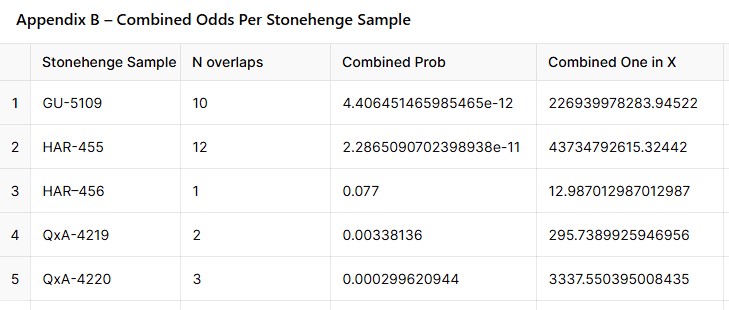
(The Stonehenge Code)
Author’s Biography
Robert John Langdon, a polymathic luminary, emerges as a writer, historian, and eminent specialist in LiDAR Landscape Archaeology.
His intellectual voyage has interwoven with stints as an astute scrutineer for governmental realms and grand corporate bastions, a tapestry spanning British Telecommunications, Cable and Wireless, British Gas, and the esteemed University of London.
A decade hence, Robert’s transition into retirement unfurled a chapter of insatiable curiosity. This phase saw him immerse himself in Politics, Archaeology, Philosophy, and the enigmatic realm of Quantum Mechanics. His academic odyssey traversed the venerable corridors of knowledge hubs such as the Museum of London, University College London, Birkbeck College, The City Literature Institute, and Chichester University.
In the symphony of his life, Robert is a custodian of three progeny and a pair of cherished grandchildren. His sanctuary lies ensconced in the embrace of West Wales, where he inhabits an isolated cottage, its windows framing a vista of the boundless sea – a retreat from the scrutinous gaze of the Her Majesty’s Revenue and Customs, an amiable clandestinity in the lap of nature’s embrace.
(The Stonehenge Code)
Exploring Prehistoric Britain: A Journey Through Time
My blog delves into the fascinating mysteries of prehistoric Britain, challenging conventional narratives and offering fresh perspectives based on cutting-edge research, particularly using LiDAR technology. I invite you to explore some key areas of my research. For example, the Wansdyke, often cited as a defensive structure, is re-examined in light of new evidence. I’ve presented my findings in my blog post Wansdyke: A British Frontier Wall – ‘Debunked’, and a Wansdyke LiDAR Flyover video further visualizes my conclusions.
My work also often challenges established archaeological dogma. I argue that many sites, such as Hambledon Hill, commonly identified as Iron Age hillforts are not what they seem. My posts Lidar Investigation Hambledon Hill – NOT an ‘Iron Age Fort’ and Unmasking the “Iron Age Hillfort” Myth explore these ideas in detail and offer an alternative view. Similarly, sites like Cissbury Ring and White Sheet Camp, also receive a re-evaluation based on LiDAR analysis in my posts Lidar Investigation Cissbury Ring through time and Lidar Investigation White Sheet Camp, revealing fascinating insights into their true purpose. I have also examined South Cadbury Castle, often linked to the mythical Camelot56.
My research also extends to the topic of ancient water management, including the role of canals and other linear earthworks. I have discussed the true origins of Car Dyke in multiple posts including Car Dyke – ABC News PodCast and Lidar Investigation Car Dyke – North Section, suggesting a Mesolithic origin2357. I also explore the misidentification of Roman aqueducts, as seen in my posts on the Great Chesters (Roman) Aqueduct. My research has also been greatly informed by my post-glacial flooding hypothesis which has helped to inform the landscape transformations over time. I have discussed this hypothesis in several posts including AI now supports my Post-Glacial Flooding Hypothesis and Exploring Britain’s Flooded Past: A Personal Journey
Finally, my blog also investigates prehistoric burial practices, as seen in Prehistoric Burial Practices of Britain and explores the mystery of Pillow Mounds, often mistaken for medieval rabbit warrens, but with a potential link to Bronze Age cremation in my posts: Pillow Mounds: A Bronze Age Legacy of Cremation? and The Mystery of Pillow Mounds: Are They Really Medieval Rabbit Warrens?. My research also includes the astronomical insights of ancient sites, for example, in Rediscovering the Winter Solstice: The Original Winter Festival. I also review new information about the construction of Stonehenge in The Stonehenge Enigma.
(The Stonehenge Code)
Further Reading
For those interested in British Prehistory, visit www.prehistoric-britain.co.uk, a comprehensive resource featuring an extensive collection of archaeology articles, modern LiDAR investigations, and groundbreaking research. The site also includes insights and extracts from the acclaimed Robert John Langdon Trilogy, a series of books exploring Britain during the Prehistoric period. Titles in the trilogy include The Stonehenge Enigma, Dawn of the Lost Civilisation, and The Post Glacial Flooding Hypothesis, offering compelling evidence about ancient landscapes shaped by post-glacial flooding.
To further explore these topics, Robert John Langdon has developed a dedicated YouTube channel featuring over 100 video documentaries and investigations that complement the trilogy. Notable discoveries and studies showcased on the channel include 13 Things that Don’t Make Sense in History and the revelation of Silbury Avenue – The Lost Stone Avenue, a rediscovered prehistoric feature at Avebury, Wiltshire.
In addition to his main works, Langdon has released a series of shorter, accessible publications, ideal for readers delving into specific topics. These include:
- The Ancient Mariners
- Stonehenge Built 8300 BCE
- Old Sarum
- Prehistoric Rivers
- Dykes, Ditches, and Earthworks
- Echoes of Atlantis
- Homo Superior
- 13 Things that Don’t Make Sense in History
- Silbury Avenue – The Lost Stone Avenue
- Offa’s Dyke
- The Stonehenge Enigma
- The Post-Glacial Flooding Hypothesis
- The Stonehenge Hoax
- Dawn of the Lost Civilisation
- Darwin’s Children
- Great Chester’s Roman Aqueduct
- Wansdyke
For active discussions and updates on the trilogy’s findings and recent LiDAR investigations, join our vibrant community on Facebook. Engage with like-minded enthusiasts by leaving a message or contributing to debates in our Facebook Group.
Whether through the books, the website, or interactive videos, we aim to provide a deeper understanding of Britain’s fascinating prehistoric past. We encourage you to explore these resources and uncover the mysteries of ancient landscapes through the lens of modern archaeology.
For more information, including chapter extracts and related publications, visit the Robert John Langdon Author Page. Dive into works such as The Stonehenge Enigma or Dawn of the Lost Civilisation, and explore cutting-edge theories that challenge traditional historical narratives.
(The Stonehenge Code)
Other Blogs
1
a
- AI now Supports – Homo Superior
- AI now supports my Post-Glacial Flooding Hypothesis
- Alexander the Great sailed into India – where no rivers exist today
- Ancient Prehistoric Canals – The Vallum
- Ancient Secrets of Althorp – debunked
- Antler Picks built Ancient Monuments – yet there is no real evidence
- Antonine Wall – Prehistoric Canals (Dykes)
- Archaeological ‘pulp fiction’ – has archaeology turned from science?
- Archaeological Pseudoscience
- Archaeology in the Post-Truth Era
- Archaeology: A Bad Science?
- Archaeology: A Harbour for Fantasists?
- Archaeology: Fact or Fiction?
- Archaeology: The Flaws of Peer Review
- Archaeology’s Bayesian Mistake: Stop Averaging the Past
- Are Raised Beaches Archaeological Pseudoscience?
- Atlantis Found: The Mathematical Proof That Plato’s Lost City Was Doggerland
- ATLANTIS: Discovery with Dan Snow Debunked
- Avebury Ditch – Avebury Phase 2
- Avebury Post-Glacial Flooding
- Avebury through time
- Avebury’s great mystery revealed
- Avebury’s Lost Stone Avenue – Flipbook
b
- Battlesbury Hill – Wiltshire
- Beyond Stone and Bone: Rethinking the Megalithic Architects of Northern Europe
- BGS Prehistoric River Map
- Blackhenge: Debunking the Media misinterpretation of the Stonehenge Builders
- Brain capacity (Cro-Magnon Man)
- Brain capacity (Cro-Magnon Man)
- Britain’s First Road – Stonehenge Avenue
- Britain’s Giant Prehistoric Waterways
- British Roman Ports miles away from the coast
c
- Caerfai Promontory Fort – Archaeological Nonsense
- Car Dyke – ABC News PodCast
- Car Dyke – North Section
- CASE STUDY – An Inconvenient TRUTH (Craig Rhos Y Felin)
- Case Study – River Avon
- Case Study – Woodhenge Reconstruction
- Chapter 2 – Craig Rhos-Y-Felin Debunked
- Chapter 2 – Stonehenge Phase I
- Chapter 2 – Variation of the Species
- Chapter 3 – Post Glacial Sea Levels
- Chapter 3 – Stonehenge Phase II
- Chapter 7 – Britain’s Post-Glacial Flooding
- Cissbury Ring through time
- Cro-Magnon Megalithic Builders: Measurement, Biology, and the DNA
- Cro-Magnons – An Explainer
d
- Darwin’s Children – Flipbook
- Darwin’s Children – The Cro-Magnons
- Dawn of the Lost Civilisation – Flipbook
- Dawn of the Lost Civilisation – Introduction
- Digging for Britain – Cerne Abbas 1 of 2
- Digging for Britain Debunked – Cerne Abbas 2
- Digging Up Britain’s Past – Debunked
- DLC Chapter 1 – The Ascent of Man
- Durrington Walls – Woodhenge through time
- Dyke Construction – Hydrology 101
- Dykes Ditches and Earthworks
- DYKES of Britain
e
f
g
h
- Hadrian’s Wall – Military Way Hoax
- Hadrian’s Wall – the Stanegate Hoax
- Hadrian’s Wall LiDAR investigation
- Hambledon Hill – NOT an ‘Iron Age Fort’
- Hayling Island Lidar Maps
- Hidden Sources of Ancient Dykes: Tracing Underground Groundwater Fractals
- Historic River Avon
- Hollingsbury Camp Brighton
- Hollows, Sunken Lanes and Palaeochannels
- Homo Superior – Flipbook
- Homo Superior – History’s Giants
- How Lidar will change Archaeology
i
l
m
- Maiden Castle through time
- Mathematics Meets Archaeology: Discovering the Mesolithic Origins of Car Dyke
- Mesolithic River Avon
- Mesolithic Stonehenge
- Minerals found in Prehistoric and Roman Quarries
- Mining in the Prehistoric to Roman Period
- Mount Caburn through time
- Mysteries of the Oldest Boatyard Uncovered
- Mythological Dragons – a non-existent animal that is shared by the World.
o
- Offa’s Dyke Flipbook
- Old Sarum Lidar Map
- Old Sarum Through Time…………….
- On Sunken Lands of the North Sea – Lived the World’s Greatest Civilisation.
- OSL Chronicles: Questioning Time in the Geological Tale of the Avon Valley
- Oswestry LiDAR Survey
- Oswestry through time
- Oysters in Archaeology: Nature’s Ancient Water Filters?
p
- Pillow Mounds: A Bronze Age Legacy of Cremation?
- Post Glacial Flooding – Flipbook
- Prehistoric Burial Practices of Britain
- Prehistoric Canals – Wansdyke
- Prehistoric Canals – Wansdyke
- Prehistoric Canals (Dykes) – Great Chesters Aqueduct (The Vallum Pt. 4)
- Prehistoric Canals (Dykes) – Hadrian’s Wall Vallum (pt 1)
- Prehistoric Canals (Dykes) – Offa’s Dyke (Chepstow)
- Prehistoric Canals (Dykes) – Offa’s Dyke (LiDAR Survey)
- Prehistoric Canals (Dykes) – Offa’s Dyke Survey (End of Section A)
- Prehistoric Canals (Dykes) – Wansdyke (4)
- Prehistoric Canals Wansdyke 2
- Professor Bonkers and the mad, mad World of Archaeology
r
- Rebirth in Stone: Decrypting the Winter Solstice Legacy of Stonehenge
- Rediscovering the Winter Solstice: The Original Winter Festival
- Rethinking Ancient Boundaries: The Vallum and Offa’s Dyke”
- Rethinking Ogham: Could Ireland’s Oldest Script Have Begun as a Tally System?
- Rethinking The Past: Mathematical Proof of Langdon’s Post-Glacial Flooding Hypothesis
- Revolutionising History: Car Dyke Unveiled as Prehistoric & the Launch of FusionBook 360
- Rising Evidence, Falling Rivers: The Real Story of Europe’s First Farmers
- Rivers of the Past Were Higher: A Fresh Perspective on Prehistoric Hydrology
s
- Sea Level Changes
- Section A – NY26SW
- Section B – NY25NE & NY26SE
- Section C – NY35NW
- Section D – NY35NE
- Section E – NY46SW & NY45NW
- Section F – NY46SE & NY45NE
- Section G – NY56SW
- Section H – NY56NE & NY56SE
- Section I – NY66NW
- Section J – NY66NE
- Section K – NY76NW
- Section L – NY76NE
- Section M – NY87SW & NY86NW
- Section N – NY87SE
- Section O – NY97SW & NY96NW
- Section P – NY96NE
- Section Q – NZ06NW
- Section R – NZ06NE
- Section S – NZ16NW
- Section T – NZ16NE
- Section U – NZ26NW & NZ26SW
- Section V – NZ26NE & NZ26SE
- Silbury Avenue – Avebury’s First Stone Avenue
- Silbury Hill
- Silbury Hill / Sanctuary – Avebury Phase 3
- Somerset Plain – Signs of Post-Glacial Flooding
- South Cadbury Castle – Camelot
- Statonbury Camp near Bath – an example of West Wansdyke
- Stone me – the druids are looking the wrong way on Solstice day
- Stone Money – Credit System
- Stone Transportation and Dumb Censorship
- Stonehenge – Monument to the Dead
- Stonehenge Hoax – Dating the Monument
- Stonehenge Hoax – Round Monument?
- Stonehenge Hoax – Summer Solstice
- Stonehenge LiDAR tour
- Stonehenge Phase 1 — Britain’s First Monument
- Stonehenge Phase I (The Stonehenge Landscape)
- Stonehenge Solved – Pythagorean maths put to use 4,000 years before he was born
- Stonehenge Stone Transportation
- Stonehenge Through Time
- Stonehenge, Doggerland and Atlantis connection
- Stonehenge: Discovery with Dan Snow Debunked
- Stonehenge: The Worlds First Computer
- Stonehenge’s The Lost Circle Revealed – DEBUNKED
t
- Ten Reasons Why Car Dyke Blows Britain’s Earthwork Myths Out of the Water
- Ten Things You Didn’t Know About Britain’s Prehistoric Flooded Past
- Ten thousand year old boats found on Northern Europe’s Hillsides
- Ten thousand-year-old boats found on Northern Europe’s Hillsides
- The “Hunter-Gatherer” Myth: Why It’s Time to Bury This Outdated Term
- The Ancient Mariners – Flipbook
- The Ancient Mariners – Prehistoric seafarers of the Mesolithic
- The Beringian Migration Myth: Why the Peopling of the Americas by Foot is Mathematically and Logistically Impossible
- The Bluestone Enigma
- The Cro-Magnon Cover-Up: How DNA and PR Labels Erased Our Real Ancestry
- The Dolmen and Long Barrow Connection
- The Durrington Walls Hoax – it’s not a henge?
- The Dyke Myth Collapses: Excavation and Dating Prove Britain’s Great Dykes Are Prehistoric Canals
- The First European Smelted Bronzes
- The Fury of the Past: Natural Disasters in Historical and Prehistoric Britain
- The Giant’s Graves of Cumbria
- The Giants of Prehistory: Cro-Magnon and the Ancient Monuments
- The Great Antler Pick Hoax
- The Great Chichester Hoax – A Bridge too far?
- The Great Dorchester Aqueduct Hoax
- The Great Farming Hoax – (Einkorn Wheat)
- The Great Farming Migration Hoax
- The Great Hadrian’s Wall Hoax
- The Great Iron Age Hill Fort Hoax
- The Great Offa’s Dyke Hoax
- The Great Prehistoric Migration Hoax
- The Great Stone Transportation Hoax
- The Great Stonehenge Hoax
- The Great Wansdyke Hoax
- The Henge and River Relationship
- The Logistical Impossibility of Defending Maiden Castle
- The Long Barrow Mystery
- The Long Barrow Mystery: Unraveling Ancient Connections
- The Lost Island of Avalon – revealed
- The Maiden Way Hoax – A Closer Look at an Ancient Road’s Hidden History
- The Maths – LGM total ice volume
- The Mystery of Pillow Mounds: Are They Really Medieval Rabbit Warrens?
- The Old Sarum Hoax
- The Oldest Boat Yard in the World found in Wales
- The Perils of Paradigm Shifts: Why Unconventional Hypotheses Get Branded as Pseudoscience
- The Post-Glacial Flooding Hypothesis – Flipbook
- The Post-Glacial Flooding Theory
- The Problem with Hadrian’s Vallum
- The Rise of the Cro-Magnon (Homo Superior)
- The Roman Military Way Hoax
- The Silbury Hill Lighthouse?
- The Stonehenge Avenue
- The Stonehenge Avenue
- The Stonehenge Code: Unveiling its 10,000-Year-Old Secret
- The Stonehenge Enigma – Flipbook
- The Stonehenge Enigma: What Lies Beneath? – Debunked
- The Stonehenge Hoax – Bluestone Quarry Site
- The Stonehenge Hoax – Flipbook
- The Stonehenge Hoax – Moving the Bluestones
- The Stonehenge Hoax – Periglacial Stripes
- The Stonehenge Hoax – Station Stones
- The Stonehenge Hoax – Stonehenge’s Location
- The Stonehenge Hoax – The Ditch
- The Stonehenge Hoax – The Slaughter Stone
- The Stonehenge Hoax – The Stonehenge Layer
- The Stonehenge Hoax – Totem Poles
- The Stonehenge Hoax – Woodhenge
- The Stonehenge Hospital
- The Subtropical Britain Hoax
- The Troy, Hyperborea and Atlantis Connection
- The Vallum @ Hadrian’s Wall – it’s Prehistoric!
- The Vallum at Hadrian’s Wall (Summary)
- The Woodhenge Hoax
- Three Dykes – Kidland Forest
- Top Ten misidentified Fire Beacons in British History
- Troy Debunked
- TSE – DVD Barrows
- TSE DVD – An Inconvenient Truth
- TSE DVD – Antler Picks
- TSE DVD – Avebury
- TSE DVD – Durrington Walls & Woodhenge
- TSE DVD – Dykes
- TSE DVD – Epilogue
- TSE DVD – Stonehenge Phase I
- TSE DVD – Stonehenge Phase II
- TSE DVD – The Post-Glacial Hypothesis
- TSE DVD Introduction
- TSE DVD Old Sarum
- Twigs, Charcoal, and the Death of the Saxon Dyke Myth
w
- Wansdyke – Short Film
- Wansdyke East – Prehistoric Canals
- Wansdyke Flipbook
- Wansdyke LiDAR Flyover
- Wansdyke: A British Frontier Wall – ‘Debunked’
- Was Columbus the first European to reach America?
- White Sheet Camp
- Why a Simple Fence Beats a Massive Dyke (and What That Means for History)
- Windmill Hill – Avebury Phase 1
- Winter Solstice – Science, Propaganda and Indoctrination
- Woodhenge – the World’s First Lighthouse?
(The Stonehenge Code)


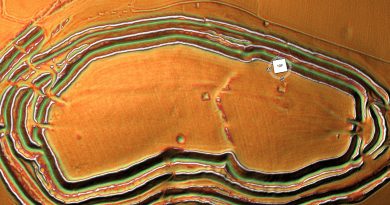
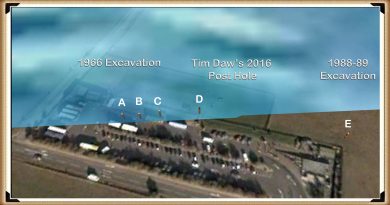
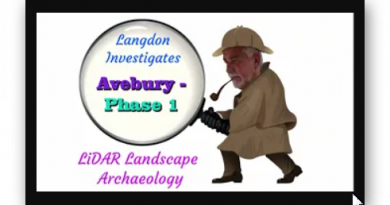
Pingback: Archaeology: A Bad Science? - Prehistoric Britain
Pingback: 2024 Prehistoric Britain Blog Review - Prehistoric Britain